Spatial Variability of Atmosphere Dust Fallout Flux in Urban–Industrial Environments
Abstract
1. Introduction
2. Experiments
2.1. Study Area
2.2. Sampling Site
2.3. Particulate Matter Collection Methodology
2.4. Scanning Electron Microscopy Analysis—SEM
2.5. Meteorological Data
2.6. Data Analysis Tools
3. Results
3.1. Climatological Data
3.2. Particulate Matter Deposition Flux
3.3. Spatial Dispersion for Particulate Matter Deposition Flux
- Point Nº 1—Corresponds to SP24, placed in a green area but also near a smoking spot.
- Point Nº 2—Located in the Hospital São João (SP28). This area is highly exposed to road traffic.
- Point Nº 3—Contribution of both SP33, placed in smoking and road traffic zones, and SP34, set in a zone also influenced by the road traffic.
- A—Corresponds to SP7, the cafeteria of the Faculty of Engineering. Here, the deposition flux is influenced by the car traffic of the parking lot—P1 (SP6) and the chimneys of the cafeteria.
- B—Includes the parking lot of the Faculty of Economics (SP10) and the Crematorium of Paranhos (SP13). Both are located facing Dr Roberto Frias Street, a road with high traffic, which may be the justification for the obtained values. Regarding the Crematorium, the high deposition of particles can be explained by the presence of the incineration chimneys.
- C—Corresponds to the sampling points within the Nursery School facilities (SP30 and SP31). The high amount of particulate matter collected in this area can be justified by the road traffic and the presence of the subway line as well. During this sampling campaign, the wind direction was predominantly towards SE, where ESEP (Higher School of Education) is located.
- Point Nº 1—Includes SP23 (parking lot ESE) and SP28.
- Point Nº 2—Corresponds to the SP7.
- A—Corresponds to SP6.
- B—Located in the Student Association of the Faculty of Engineering, SP5, which corresponds to a smoking spot.
- C—Corresponds to the Crematorium of Paranhos (SP13).
- D—Corresponds to the parking lot of the Faculty of Sports (SP16).
- Point Nº 1—Corresponds to SP7.
- Point Nº 2—Corresponds to the SP18 (IPATIMUP’s building) located near a high traffic zone (parking lot and Dr Roberto Frias Street). During this sampling period, the wind direction was towards the south coincident with the location of the collector.
- A—Includes the SP25 surrounded by the canteen chimneys of the ESE.
- Point Nº 1—Corresponds to SP7.
- Point Nº 2—Corresponds to SP18.
- A—Corresponds to SP25.
- Point Nº 1—includes SP23 and SP28. During this sampling campaign, there were several raining events that may have promoted the washing of the dust fallout, decreasing the collected flux.
- Point Nº 1—Corresponds to SP25.
- Point Nº 2—Corresponds to SP28.
- Point Nº 3—Influenced by both SP33 and SP34.
- A—Influenced by both SP10 and SP13.
- B—Corresponds to SP7.
- C—Influenced by both SP30 and SP31.
3.4. Particulate Matter Analysis by SEM
4. Discussion
5. Conclusions
Author Contributions
Funding
Conflicts of Interest
References
- U.S. EPA. Integrated Science Assessment (ISA) for Particulate Matter (Final Report, 2019). EPA/600/R–19/188. Available online: https://cfpub.epa.gov/ncea/isa/recordisplay.cfm?deid=347534 (accessed on 9 September 2020).
- WHO. Air Pollution. Available online: http://www.who.int/airpollution/en/ (accessed on 17 August 2020).
- Manisalidis, I.; Stavropoulou, E.; Stavropoulos, A.; Bezirtzoglou, E. Environmental and Health Impacts of Air Pollution: A Review. J. Front. Public Health 2020, 8. [Google Scholar] [CrossRef]
- Kelishadi, R.; Poursafa, P. Air pollution and non–respiratory health hazards for children. Arch. Med. Sci. 2010, 6, 483–495. [Google Scholar] [CrossRef]
- AduGyamfi, V.; Cobbina, S.J.; Dampare, S.B.; Duwiejuah, A.B. Heavy metals concentration in road dust in the Bolgatanga municipality, Ghana. J. Environ. Pollut. Human Health 2014, 2, 74–80. [Google Scholar]
- European Environmental Agency. EEA.EMEP Air Pollutant Emission Inventory Guidebook. In Technical Guidance to Prepare National Emission Inventories; EEA Report No 13/2019; European Environmental Agency: Copenhagen, Denmark, 2019; ISSN 1977–8449. [Google Scholar]
- Amato, F.; Querol, X.; Johansson, C.; Nagl, C.; Alastuey, A. A review on the effectiveness of street sweeping, washing and dust suppressants as urban PM control methods. Sci. Total Environ. 2010, 408, 3070–3084. [Google Scholar] [CrossRef] [PubMed]
- Schauer, J.J.; Lough, G.C.; Shafer, M.M.; Christensen, W.C.; Arndt, M.F.; DeMinter, J.T.; Park, J.S. Characterization of emissions of metals emitted from motor vehicles. Research report 133. Health Effects Inst. 2006, 133, 77–88. [Google Scholar]
- Pant, P.; Harrison, R.M. Estimation of the contribution of road traffic emissions to particulate matter concentrations from field measurements: A review. Atmos. Environ. 2013, 77, 78–97. [Google Scholar] [CrossRef]
- Xing, Y.F.; Xu, Y.H.; Shi, M.H.; Lian, Y.X. The impact of PM2.5 on the human respiratory system. J. Thorac. Dis. 2016, 8, E69–E74. [Google Scholar] [CrossRef] [PubMed]
- Chen, J.; Hoek, G. Long–term exposure to PM and all–cause and cause–specific mortality: A systematic review and meta–analysis. Environ. Int. 2020. [Google Scholar] [CrossRef]
- Lin., S.; Munsie, J.P.; Hwang, S.A.; Fitzgerald, E.; Cayo, M.R. Childhood asthma hospitalization and residential exposure to state route traffic. Environ. Res. 2002, 88, 73–81. [Google Scholar] [CrossRef]
- Lippmann, M.; Chen, L.C. Health effects of concentrated ambient air particulate matter (CAPs) and its components. Crit. Rev. Toxicol. 2009, 39, 865–913. [Google Scholar] [CrossRef]
- Fanning, E.; Froines, J.; Utell, M.; Lippmann, M.; Oberdorster, G.; Godleski, J.; Larson, T. Accomplishments of the particulate matter (PM) research centers (1999–2005) and the role of interdisciplinary center–based research. Environ. Health Perspect. 2009, 117, 167–174. [Google Scholar] [CrossRef] [PubMed]
- Schlesinger, R.B.; Kunzli, N.; Hidy, G.M.; Gotschi, T.; Jerrett, M. The health relevance of ambient particulate matter characteristics: Coherence of toxicological and epidemiological inferences. Inhal. Toxicol. 2006, 18, 95–125. [Google Scholar] [CrossRef] [PubMed]
- Lighthart, B. The ecology of bacteria in the alfresco atmosphere. FEMS Microbiol. Ecol. 1997, 23, 263–274. [Google Scholar] [CrossRef]
- Alghamdi, M.A.; Shamy, M.; Redal, M.A.; Khoder, M.; Awad, A.H.; Elserougy, S. Microorganisms associated particulate matter: A preliminary study. Sci. Total Environ. 2014, 479, 109–116. [Google Scholar] [CrossRef]
- World Health Organization Regional Office for Europe. Air Quality Guidelines, 2nd ed.; WHO Regional Publications: Copenhagen, Denmark, 2000; pp. 186–193. [Google Scholar]
- Kgabi, N.A.; Pienaar, J.J.; Kulmala, M. Characterisation of Inhalable Atmospheric Particulate Aerosols. In Air Pollution XVI; Brebbia, C.A., Longhurst, J.W.S., Eds.; WIT Press: Southampton, UK, 2008; pp. 323–334. [Google Scholar]
- Utsunomiya, S.; Jensen, K.A.; Keeler, G.J.; Ewing, R.C. Direct identification of trace metals in fine and ultrafine particles in the Detroit urban atmosphere. Environ. Sci. Technol. 2004, 38, 2289–2297. [Google Scholar] [CrossRef]
- Ro, C.U.; Oh, K.Y.; Kim, H.; Chun, Y.; Osán, J.; de Hoog, J.; van Grieken, R. Chemical speciation of individual atmospheric particles using low–Z electron probe X–ray microanalysis: Characterizing “Asian Dust” deposited with rainwater in Seoul, Korea. Atmos. Environ. 2001, 35, 4995–5005. [Google Scholar] [CrossRef]
- Geng, H.; Kang, H.; Jung, J.; Choel, M.; Kim, H.; Ro, C.U. Characterization of individual submicrometer aerosol particles collected in Incheon, Korea, by quantitative transmission electron microscopy energy–dispersive X–ray spectrometry. J. Geophys. Res. 2010, 115, D15306. [Google Scholar] [CrossRef]
- Reist, P.C. Aerosol Science and Technology, 2nd ed.; McGraw–Hill: New York, NY, USA, 1993. [Google Scholar]
- Shingler, T.; Sorooshian, A.; Ortega, A.; Crosbie, E.; Wonaschuetz, A.; Perring, A.E.; Beyersdorf, A.; Ziemba, L.; Jimenez, J.L.; Campuzano–Jost, P.; et al. Ambient observations of hygroscopic growth factor and f(RH) below 1: Case studies from surface and airborne measurements. J. Geophys. Res. 2016, 121, 13661–13677. [Google Scholar] [CrossRef]
- Salma, I.; Maenhaut, W.; Zemplén–Papp, E.; Záray, G. Comprehensive characterisation of atmospheric aerosols in Budapest, Hungary: Physicochemical properties of inorganic species. Atmos. Environ. 2001, 35, 4367–4378. [Google Scholar] [CrossRef]
- Colls, J.; Tiwary, A. Air Pollutants: Pollution—Measurement, Modelling and Mitigation, 3rd ed.; Routledge: Abington, UK, 2010; pp. 54–88. [Google Scholar]
- Ashok, V.; Gupta, T.; Dubey, S.; Rajmal, J. Personal exposure measurement of students to various microenvironments inside and outside the college campus. Environ. Monit. Assess. 2014, 186, 735–750. [Google Scholar] [CrossRef]
- Van Malderen, H.; van Grieken, R.; Bufetov, N.V.; Koutzenogii, K.P. Chemical Characterization of Individual Aerosol Particles in Central Siberia. Environ. Sci. Technol. 1996, 30, 312–321. [Google Scholar] [CrossRef]
- Cong, Z.Y.; Kang, S.C.; Dong, S.P.; Liu, X.D.; Qin, D.H. Elemental and individual particle analysis of atmospheric aerosols from high Himalayas. Environ. Monit. Assess. 2010, 160, 323. [Google Scholar] [CrossRef] [PubMed]
- Walkden, S.; Kelley, R.; Parrish, M.; Horstwood, A.; Indares, J.; Still, J. Determining Source of Ejecta Using Heavy Mineral Provenance Techniques; A Manicouagan Distal Ejecta Case Study. Lunar Planet. Sci. 2009, 285, 163–172. [Google Scholar]
- Zereini, F.; Wiseman, L.S. Urban Airborne Particulate Matter, Origin, Chemistry, Fate and Health Impacts, 1st ed.; Springer: Berlin/Heidelberg, Germany, 2010. [Google Scholar]
- World Health Organization Regional Office for Europe. Manganese and its Compounds: Environmental Aspects; Concise International Chemical Assessment Document 63; World Health Organization: Geneve, Switzerland, 2004. [Google Scholar]
- Hernandez, H.; Berry, T.A.; Wallis, S.L.; Poyner, D. Temperature and Humidity Effects on Particulatte Matter Concentrations in a Sub–Tropical Climate During Winter. In Proceedings of the International Conference of the Environment, Chemistry and Biology (ICECB 2017), Queensland, Australia, 10–22 November 2017; pp. 41–49. [Google Scholar]
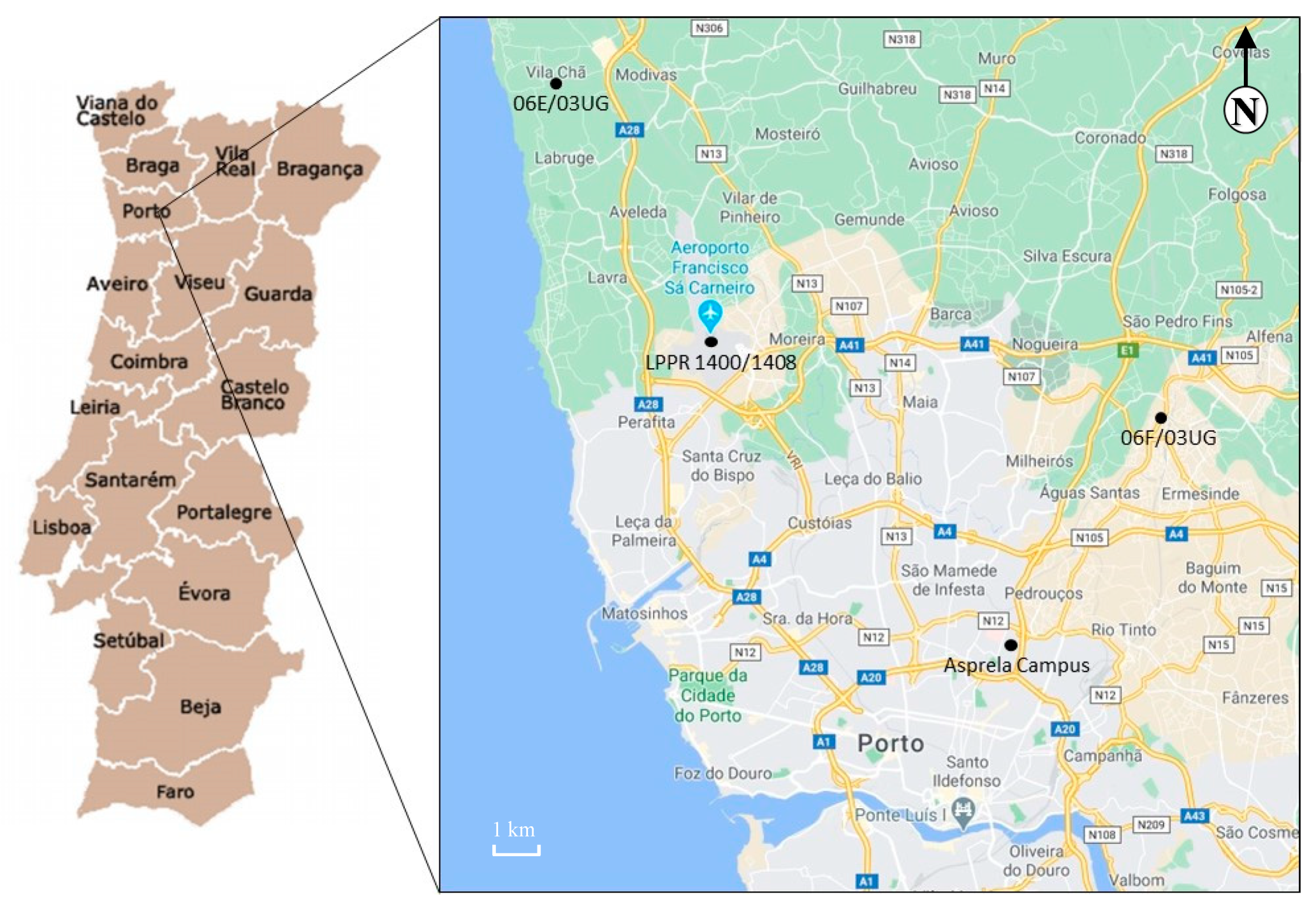
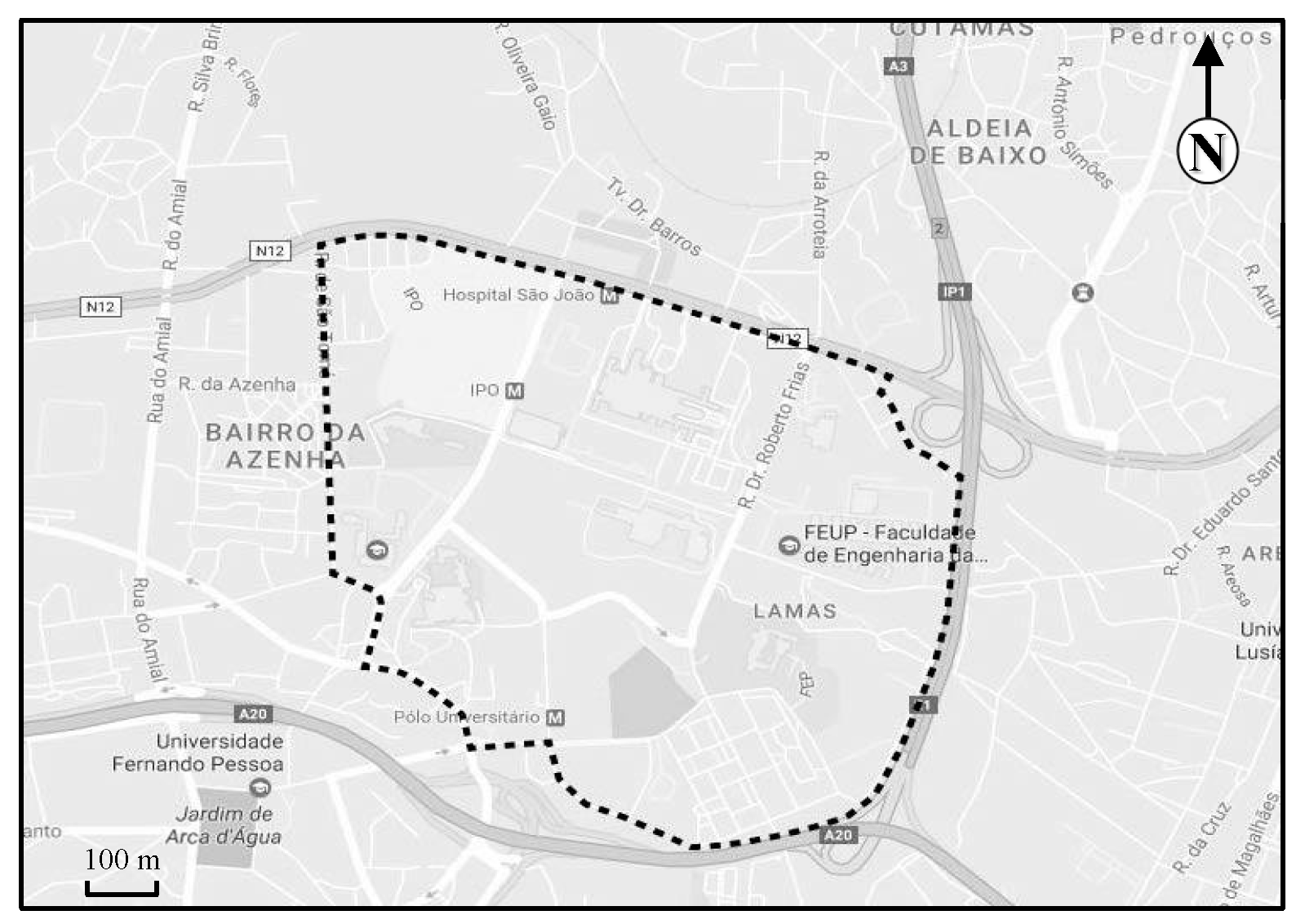
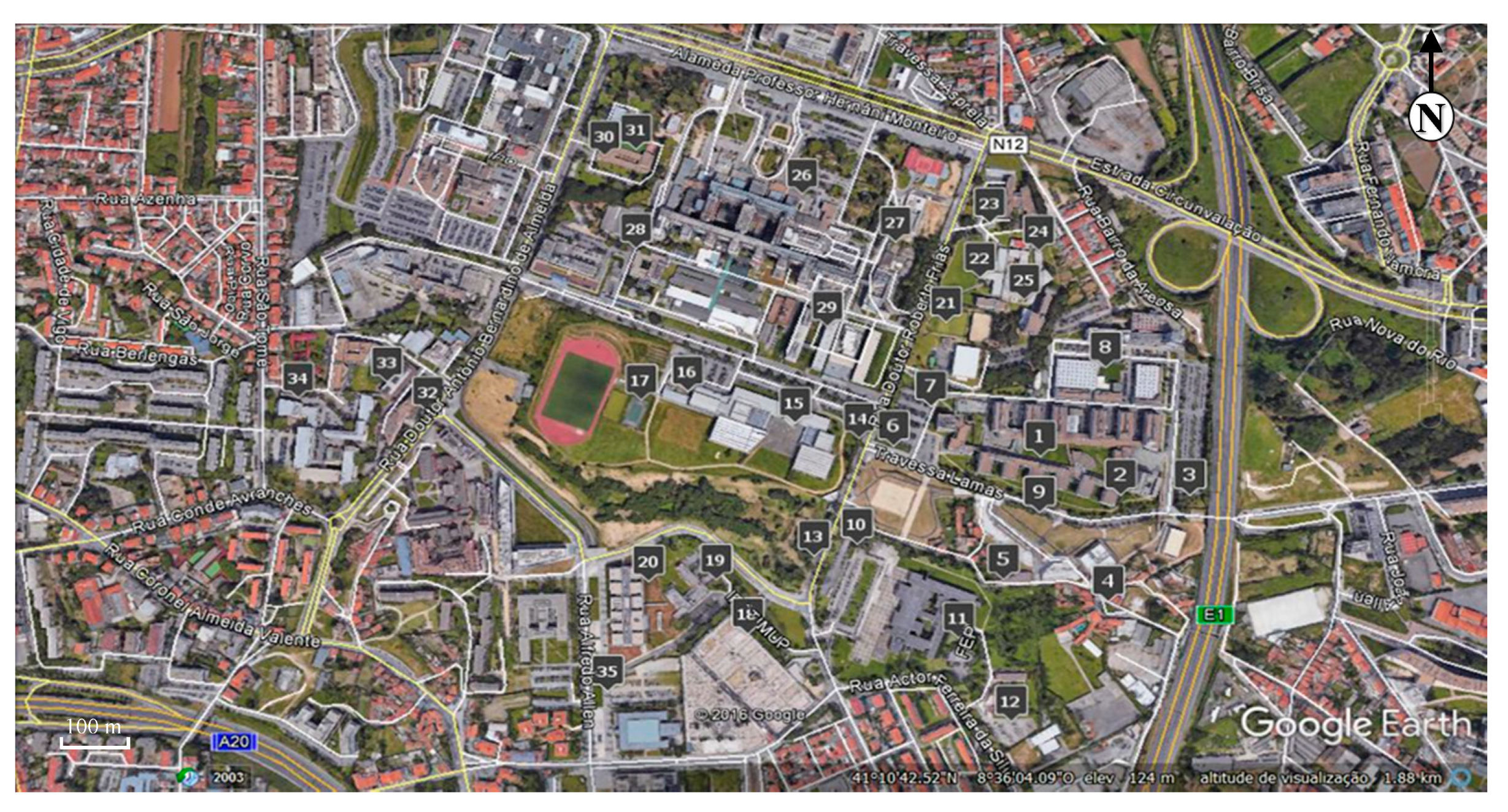
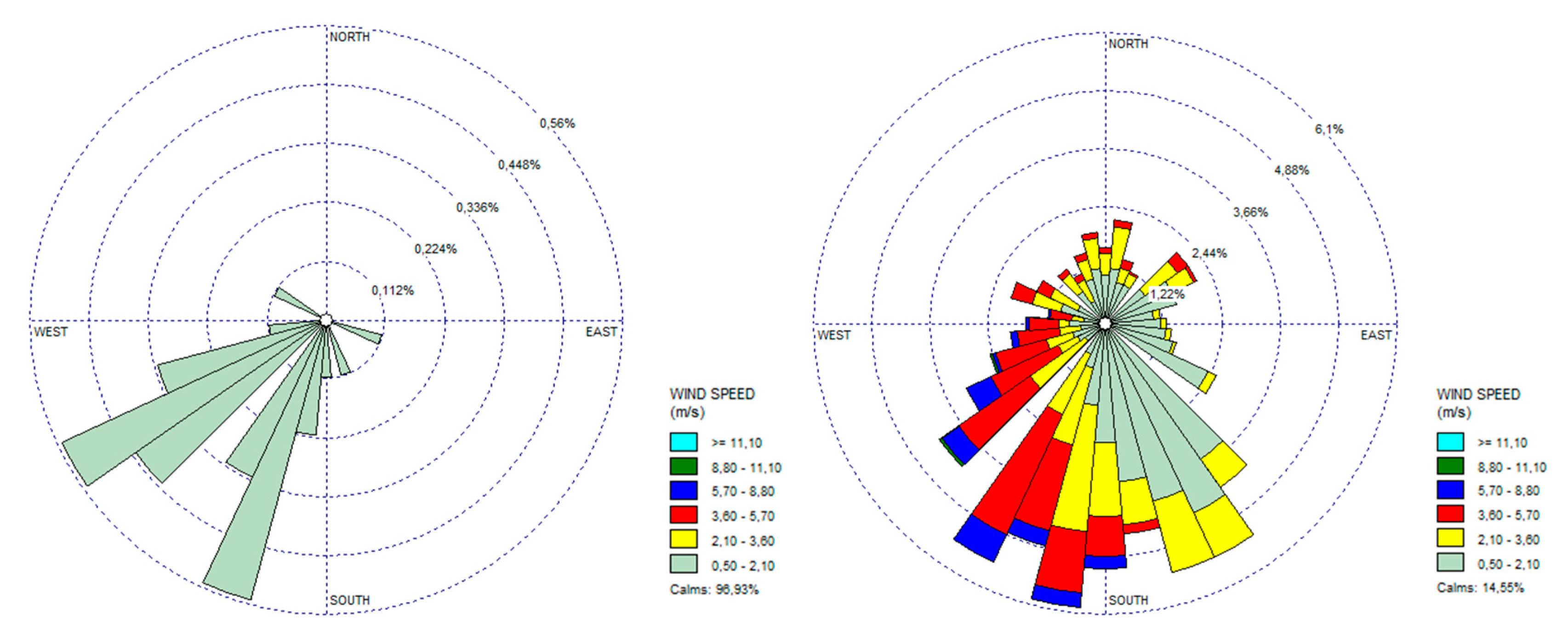
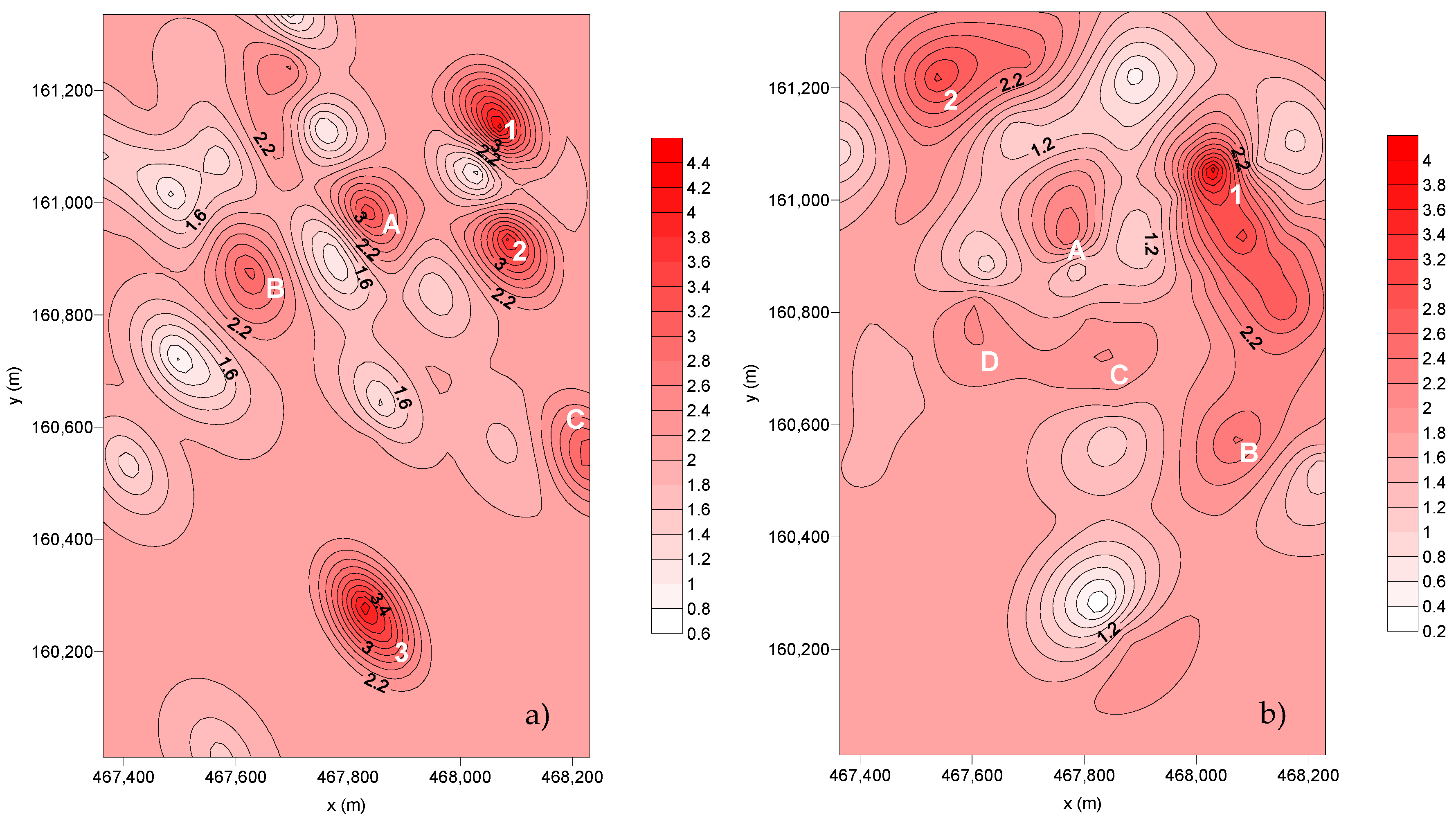
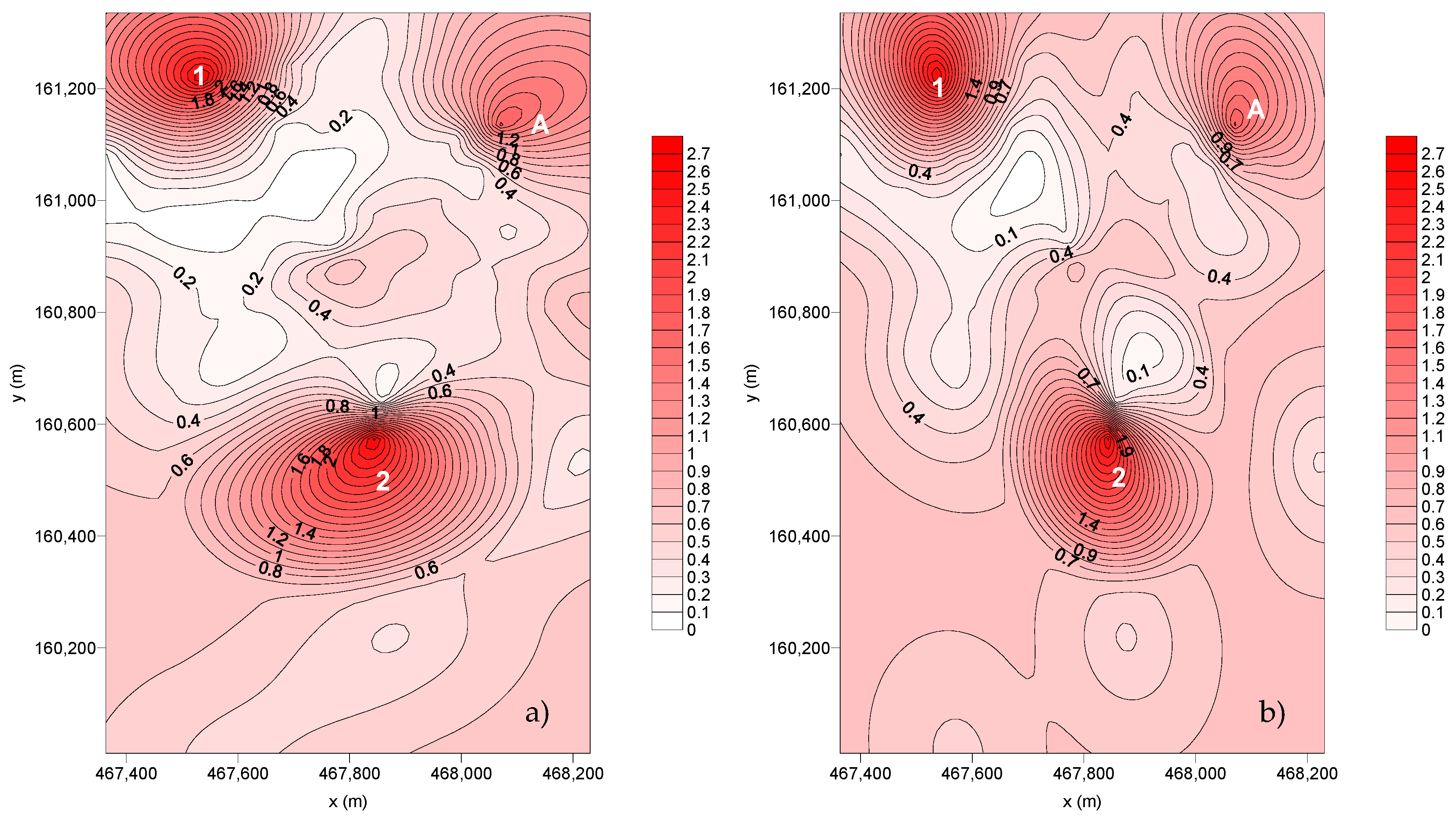
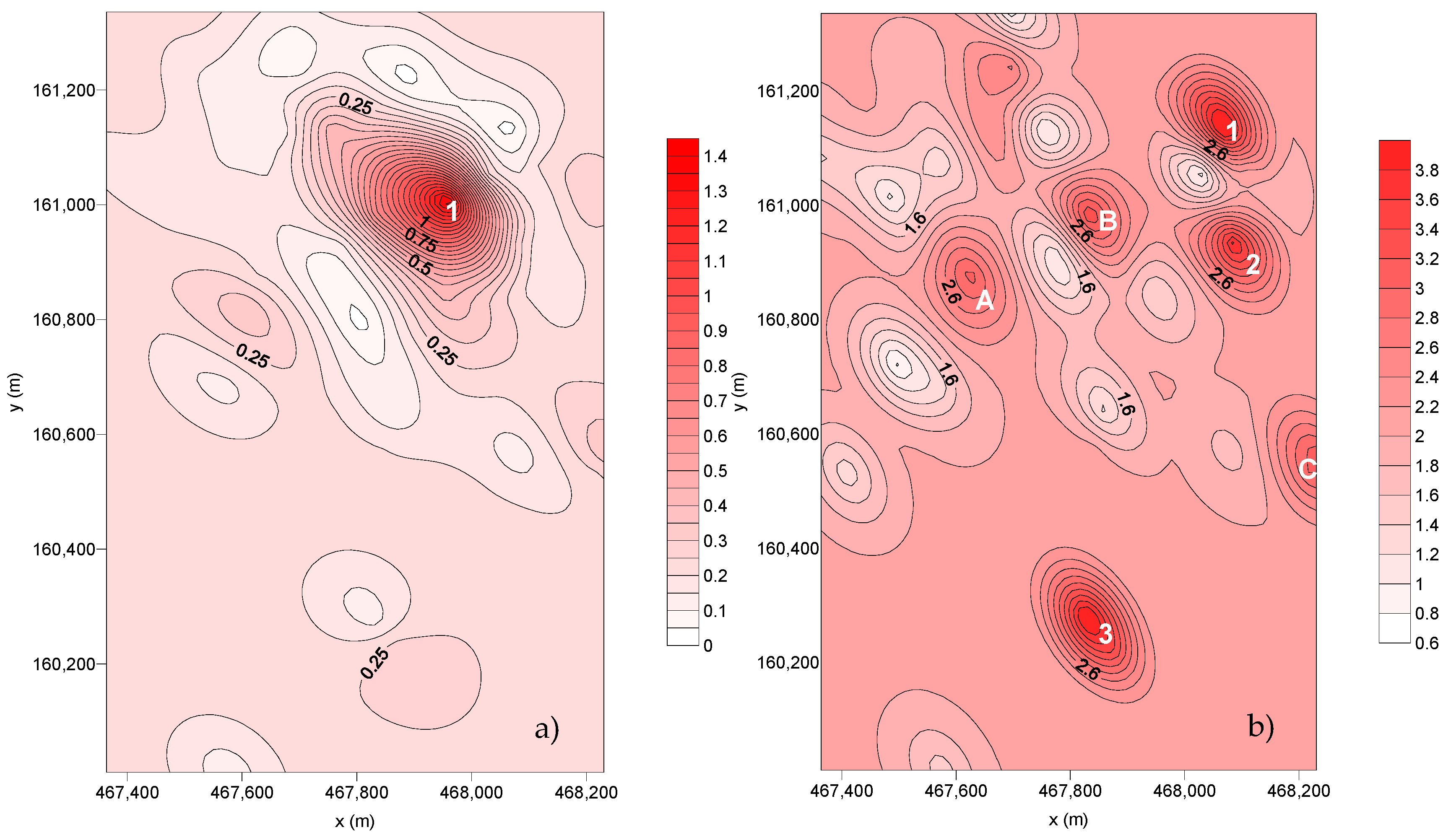





| SP Nº | Sampling Location | Possible Emission Source | |
|---|---|---|---|
| 1 | FEUP | Buildings F/G | Smoking Area, Road Traffic |
| 2 | Library | Smoking Area, Road Traffic | |
| 3 | Parking Lot P3 | Road Traffic | |
| 4 | Canteen | Chimneys, Road Traffic | |
| 5 | Students Association FEUP | Smoking Area | |
| 6 | Parking Lot P1 | Road Traffic | |
| 7 | Cafeteria | Chimneys, Road Traffic | |
| 8 | INESC | Road Traffic | |
| 9 | Bicycle Path | Green Area, Road Traffic | |
| 10 | FEP | Parking Lot Staff | Road Traffic |
| 11 | Parking Lot Students | Road Traffic | |
| 12 | Students Association FEP | Green Area | |
| 13 | CREMATORIUM | Crematorium | Chimneys, Road Traffic |
| 14 | FADEUP | Grass park | Green Area |
| 15 | Entrance | Smoking Area | |
| 16 | Parking Lot | Road Traffic | |
| 17 | Football Field | Green Area | |
| 18 | IPATIMUP | Entrance | Road Traffic |
| 19 | Parking Lot | Road Traffic, Chimneys | |
| 20 | Buildings | Green Area | |
| 21 | ESE | Tennis Field | Green Area, Road Traffic |
| 22 | Entrance | Green Area, Smoking Area | |
| 23 | Parking Lot | Road Traffic | |
| 24 | Buildings | Green Area, Smoking Area | |
| 25 | Grass Park | Green Area, Chimneys | |
| 26 | H. SÃO JOÃO | Entrance | Smoking Area, Road Traffic |
| 27 | Pediatrician Service | Construction Works, Chimneys | |
| 28 | Gynecologic/Obstetric Service | Road Traffic | |
| 29 | Students Association FMUP | Construction works, Road Traffic | |
| 30 | ESEP | Entrance | Green Area, Road Traffic, Subway |
| 31 | Parking Lot | Road Traffic | |
| 32 | ISEP | Entrance | Green Area, Road Traffic |
| 33 | Buildings | Smoking Area, Road Traffic | |
| 34 | Parking Lot | Road Traffic | |
| 35 | FDMUP | FMDUP | Road Traffic |
| Sampling Campaign Nº | Initial Date | End Date | Nº Days |
|---|---|---|---|
| 1 | 13 April | 14 May | 32 |
| 2 | 11 May | 17 June | 38 |
| 3 | 15 June | 22 July | 38 |
| 4 | 20 July | 12 October | 85 |
| 5 | 07 October | 20 November | 45 |
| 6 | 16 November | 19 January | 65 |
| 7 | 15 January | 19 February | 35 |
| SCNº | Wind Direction (°) | Wind Velocity (m/s) | Temperature (°C) | Rainfall (mm) | ||||||||||||
|---|---|---|---|---|---|---|---|---|---|---|---|---|---|---|---|---|
| µ | ±σ | Min. | Max. | µ | ±σ | Min. | Max. | µ | ±σ | Min. | Max. | µ | ±σ | Min. | Max. | |
| 1 | 186 | 31 | 129 | 259 | 0.4 | 0.4 | 0.0 | 1.7 | 15 | 2 | 12 | 21 | 0.3 | 1.8 | 0.0 | 10.1 |
| 2 | 216 | 26 | 150 | 285 | 0.1 | 0.2 | 0.0 | 0.7 | 18 | 3 | 14 | 25 | 1.0 | 5.4 | 0.0 | 33.6 |
| 3 | 206 | 19 | 168 | 240 | 0.1 | 0.1 | 0.1 | 0.4 | 19 | 2 | 17 | 27 | 0.0 | 0.0 | 0.0 | 0.0 |
| 4 | 193 | 34 | 119 | 244 | 0.3 | 0.7 | 0.0 | 3.2 | 17 | 1 | 14 | 20 | 4.4 | 15.7 | 0.0 | 96.3 |
| 5 | 179 | 39 | 109 | 250 | 1.2 | 1.2 | 0.0 | 4.0 | 16 | 2 | 13 | 20 | 3.7 | 9.3 | 0.0 | 49.2 |
| 6 | 199 | 43 | 69 | 295 | 2.7 | 1.1 | 0.9 | 5.1 | 13 | 2 | 8 | 18 | 9.0 | 11.0 | 0.0 | 43.2 |
| 7 | 181 | 67 | 69 | 303 | 2.0 | 1.0 | 0.6 | 4.5 | 11 | 3 | 6 | 17 | 4.8 | 7.3 | 0.0 | 23.4 |
| Deposition Flux (g m–2 Month–1) | Mean | ±σ | Median | Min. | Max. |
|---|---|---|---|---|---|
| SC1 | 0.5585 | 0.6271 | 0.2930 | 0.0018 | 3.1390 |
| SC2 | 2.0449 | 0.9913 | 1.9006 | 0.7355 | 4.3518 |
| SC3 | 1.7165 | 0.7650 | 1.7115 | 0.1646 | 3.9866 |
| SC4 | 0.5531 | 0.8507 | 0.3006 | 0.0145 | 4.6712 |
| SC5 | 0.5399 | 0.6068 | 0.3792 | 0.0897 | 2.6613 |
| SC6 | 0.2298 | 0.2452 | 0.1596 | 0.0199 | 1.4149 |
| SC7 | 0.2434 | 0.3096 | 0.1865 | 0.0169 | 1.8685 |
| Sampling Campaign Nº | Sampling Location Nº | |||||||||||||||
|---|---|---|---|---|---|---|---|---|---|---|---|---|---|---|---|---|
| 5 | 6 | 7 | 10 | 13 | 16 | 18 | 23 | 24 | 25 | 28 | 30 | 31 | 32 | 33 | 34 | |
| 2 | 0 | 0 | 1 | 1 | 1 | 0 | 0 | 0 | 1 | 0 | 1 | 1 | 1 | 1 | 1 | 0 |
| 3 | 1 | 1 | 1 | 0 | 1 | 1 | 0 | 1 | 0 | 0 | 1 | 0 | 0 | 0 | 0 | 0 |
| 4 | 0 | 0 | 1 | 0 | 0 | 0 | 1 | 0 | 0 | 1 | 0 | 0 | 0 | 0 | 0 | 0 |
| 5 | 0 | 0 | 1 | 0 | 0 | 0 | 1 | 0 | 0 | 1 | 0 | 0 | 0 | 0 | 0 | 0 |
| 6 | 0 | 0 | 0 | 0 | 0 | 0 | 0 | 1 | 0 | 0 | 0 | 0 | 0 | 0 | 0 | 0 |
| 7 | 0 | 0 | 1 | 1 | 1 | 0 | 0 | 0 | 0 | 1 | 1 | 1 | 1 | 0 | 1 | 1 |
| Frequency | 1 | 1 | 5 | 2 | 3 | 1 | 2 | 2 | 1 | 3 | 3 | 2 | 2 | 1 | 2 | 1 |
© 2020 by the authors. Licensee MDPI, Basel, Switzerland. This article is an open access article distributed under the terms and conditions of the Creative Commons Attribution (CC BY) license (http://creativecommons.org/licenses/by/4.0/).
Share and Cite
Dinis, M.d.L.; Gonçalves, M.I. Spatial Variability of Atmosphere Dust Fallout Flux in Urban–Industrial Environments. Atmosphere 2020, 11, 1069. https://doi.org/10.3390/atmos11101069
Dinis MdL, Gonçalves MI. Spatial Variability of Atmosphere Dust Fallout Flux in Urban–Industrial Environments. Atmosphere. 2020; 11(10):1069. https://doi.org/10.3390/atmos11101069
Chicago/Turabian StyleDinis, Maria de Lurdes, and Maria Inês Gonçalves. 2020. "Spatial Variability of Atmosphere Dust Fallout Flux in Urban–Industrial Environments" Atmosphere 11, no. 10: 1069. https://doi.org/10.3390/atmos11101069
APA StyleDinis, M. d. L., & Gonçalves, M. I. (2020). Spatial Variability of Atmosphere Dust Fallout Flux in Urban–Industrial Environments. Atmosphere, 11(10), 1069. https://doi.org/10.3390/atmos11101069






